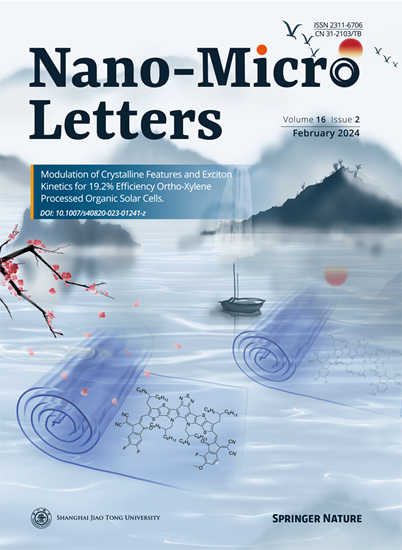单片钙钛矿/钙钛矿/硅三结太阳能电池:基本原理、进展和前景。
IF 36.3
1区 材料科学
Q1 Engineering
引用次数: 0
摘要
晶体硅(c-Si)太阳能电池虽然在光伏市场占据主导地位,但其理论功率转换效率(PCE)已接近29.4%的极限,因此需要采用多结技术来实现更高的性能。其中,钙钛矿-硅基多结太阳能电池已经成为一种有前途的替代品,钙钛矿提供可调谐的带隙,优越的光电性能和成本效益制造。最近公布的双结太阳能电池(PSDJSCs)的PCE达到了34.85%,超过了所有其他双结技术。令人鼓舞的是,PSDJSCs的快速发展激发了2024年钙钛矿/钙钛矿/硅三结太阳能电池(PSTJSCs)的研究兴趣。这种三结太阳能电池结构表现出巨大的潜力,因为它们在实现高PCE限制和管理设备复杂性之间取得了最佳平衡。这篇综述提供了PSTJSCs的全面分析,涵盖了基本原理和技术里程碑。本文还讨论了当前的挑战,包括电流失配、开路电压亏缺、相分离和稳定性问题,以及相应的策略,以及实现长期稳定性和高PCE的未来方向。本工作旨在促进对PSTJSCs发展的理解,为其实际实施铺平道路。本文章由计算机程序翻译,如有差异,请以英文原文为准。
Monolithic Perovskite/Perovskite/Silicon Triple-Junction Solar Cells: Fundamentals, Progress, and Prospects.
Crystalline silicon (c-Si) solar cells, though dominating the photovoltaic market, are nearing their theoretical power conversion efficiencies (PCE) limit of 29.4%, necessitating the adoption of multi-junction technology to achieve higher performance. Among these, perovskite-on-silicon-based multi-junction solar cells have emerged as a promising alternative, where the perovskite offering tunable bandgaps, superior optoelectronic properties, and cost-effective manufacturing. Recent announced double-junction solar cells (PSDJSCs) have achieved the PCE of 34.85%, surpassing all other double-junction technologies. Encouragingly, the rapid advancements in PSDJSCs have spurred increased research interest in perovskite/perovskite/silicon triple-junction solar cells (PSTJSCs) in 2024. This triple-junction solar cell configuration demonstrates immense potential due to their optimum balance between achieving a high PCE limit and managing device complexity. This review provides a comprehensive analysis of PSTJSCs, covering fundamental principles, and technological milestones. Current challenges, including current mismatch, open-circuit voltage deficits, phase segregation, and stability issues, and their corresponding strategies are also discussed, alongside future directions to achieve long-term stability and high PCE. This work aims to advance the understanding of the development in PSTJSCs, paving the way for their practical implementation.
求助全文
通过发布文献求助,成功后即可免费获取论文全文。
去求助
来源期刊

Nano-Micro Letters
NANOSCIENCE & NANOTECHNOLOGY-MATERIALS SCIENCE, MULTIDISCIPLINARY
CiteScore
32.60
自引率
4.90%
发文量
981
审稿时长
1.1 months
期刊介绍:
Nano-Micro Letters is a peer-reviewed, international, interdisciplinary, and open-access journal published under the SpringerOpen brand.
Nano-Micro Letters focuses on the science, experiments, engineering, technologies, and applications of nano- or microscale structures and systems in various fields such as physics, chemistry, biology, material science, and pharmacy.It also explores the expanding interfaces between these fields.
Nano-Micro Letters particularly emphasizes the bottom-up approach in the length scale from nano to micro. This approach is crucial for achieving industrial applications in nanotechnology, as it involves the assembly, modification, and control of nanostructures on a microscale.
 求助内容:
求助内容: 应助结果提醒方式:
应助结果提醒方式:


